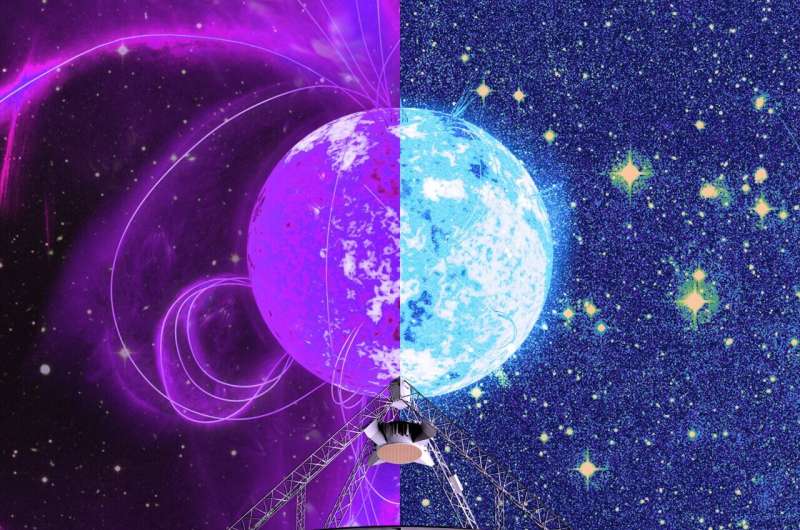This article has been reviewed according to Science X's editorial process and policies. Editors have highlighted the following attributes while ensuring the content's credibility:
fact-checked
peer-reviewed publication
trusted source
proofread
Most collapsed stars fully rotate in seconds: This one takes nearly an hour

Australian scientists from the University of Sydney and Australia's national science agency, CSIRO, have detected what is likely a neutron star spinning slower than any other ever measured.
No other radio-emitting neutron star, out of the more than 3,000 discovered so far, has been discovered rotating so slowly. The results are published in Nature Astronomy.
Lead author Dr. Manisha Caleb from the University of Sydney Institute for Astronomy said, "It is highly unusual to discover a neutron star candidate emitting radio pulsations in this way. The fact that the signal is repeating at such a leisurely pace is extraordinary."
This unusual neutron star is emitting radio light at a rate that is too slow to fit with current descriptions of radio neutron star behavior. This provides new insights into the complex life cycles of stellar objects.
At the end of their life, large stars about 10 times the mass of the sun use up all their fuel and explode in a spectacular blast we call a supernova. What remains is a stellar remnant so dense that 1.4 times the mass of our sun is packed into a ball just 20 kilometers across.
Matter is so dense that negatively charged electrons are crushed into positively charged protons, and what's left is an object made up of trillions of neutrally charged particles. A neutron star is born.
Given the extreme physics with which these stars collapse, neutron stars typically rotate mind-bendingly fast, taking just seconds or even fractions of a second to fully spin on their axis.
The discovery was made using CSIRO's ASKAP radio telescope in Wajarri Yamaji Country in Western Australia.
The ASKAP radio telescope can see a large part of the sky at once, which means it can capture things researchers aren't even looking for. CSIRO scientist Dr. Emil Lenc, co-lead author on the paper, said they wouldn't have found this strange object if it wasn't for ASKAP's unique design.
"We were simultaneously monitoring a source of gamma rays and seeking a fast radio burst when I spotted this object slowly flashing in the data. Three very different things in one field-of-view," he said. "ASKAP is one of the best telescopes in the world for this sort of research, as it is constantly scanning so much of the sky, allowing us to detect any anomalies."
The origin of such a long period signal remains a profound mystery, although two types of stars are prime suspects—white dwarfs and neutron stars.
"What is intriguing is how this object displays three distinct emission states, each with properties entirely dissimilar from the others. The MeerKAT radio telescope in South Africa played a crucial role in distinguishing between these states. If the signals didn't arise from the same point in the sky, we would not have believed it to be the same object producing these different signals," Dr. Caleb said.
While an isolated white dwarf with an extraordinarily strong magnetic field could produce the observed signal, it is surprising that nearby highly-magnetic isolated white dwarfs have never been discovered. Conversely, a neutron star with extreme magnetic fields can quite elegantly explain the observed emissions.
While a slow-spinning neutron star is the likely explanation, researchers said they cannot rule out that the object is part of a binary system with a neutron star or another white dwarf.
More research will be required to confirm whether the object is a neutron star or a white dwarf. Either way, it will provide valuable insights into the physics of these extreme objects.
"It might even prompt us to reconsider our decades-old understanding of neutron stars or white dwarfs; how they emit radio waves and what their populations are like in our Milky Way galaxy," Dr. Caleb said.
Professor Tara Murphy, leading radio astronomer and head of the School of Physics at the University of Sydney, said, "Until the advent of our new telescopes, the dynamic radio sky has been relatively unexplored. Now we're able to look deeply, and often, we are seeing all kinds of unusual phenomena. These events give us insights into how physics works in extreme environments."
More information: Caleb, M. et al. An emission state switching transient with a 54 minute period', Nature Astronomy (2024). DOI: 10.1038/s41550-024-02277-w. www.nature.com/articles/s41550-024-02277-w
Journal information: Nature Astronomy
Provided by University of Sydney





















